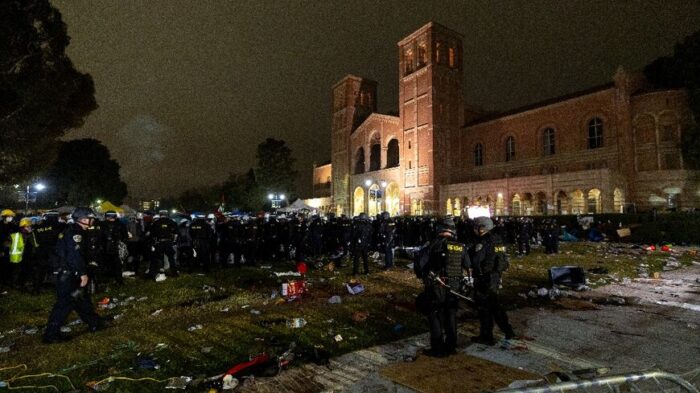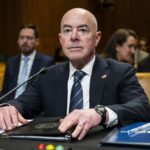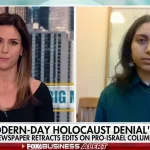A week of escalating tensions at the University of California, Los Angeles (UCLA) came to a head on Wednesday night as riot police moved in to dismantle an encampment set up by pro-Palestinian student protesters. The camp had been occupying a central lawn on campus for over seven days, with students rallying in solidarity against Israel’s military campaign in Gaza. However, clashes with pro-Israel counter-protesters earlier in the week led the university to declare the encampment an unlawful assembly, prompting the late-night police clearance operation. In this article we talk about Gaza Protest at UCLA Cleared- What Led to the Clearance?
The End of a Passive Stance
Initially, UCLA administrators had adopted a tolerant approach, hoping to avoid bringing in the police to disband the protest. This contrasted with heavy-handed responses at some other universities, including the University of Southern California (USC) where riot police shut down a similar encampment on its very first day.
UCLA opted to keep order through its own private security personnel for the first few days. However, the university later claimed this passive stance was being interpreted as acceptance. After violence flared between pro-Palestinian and pro-Israeli demonstrators on Tuesday night, UCLA leaders shifted gears. Citing safety concerns and repeated violations of university policies, officials declared the encampment an “unlawful assembly” on Wednesday. That same evening, dozens of riot police descended on the lawn to systematically dismantle the camp.
A Gradual Build-Up of Tensions
In the early days of the encampment, the atmosphere had been peaceful. Students put up tents on the lawn and hung “Free Palestine” banners, settling in for the long haul. As the week progressed though, tensions slowly mounted. On Sunday, thousands attended a high-profile pro-Israel rally just across from the encampment, waving Israeli flags and condemning Hamas. Heated arguments broke out between the two sides, setting the stage for further confrontations.
The situation reached boiling point on Tuesday when video emerged showing dozens of masked counter-protesters with weapons attacking the encampment. Students described it as a terrifying ordeal, leaving many in fear. University leaders called it an “appalling” scene of violence that could not be tolerated. This incident was the final straw that led administrators to arrange the late-night clearance by riot police.
Criticism of the University’s Shift in Response
UCLA’s firm response received praise in some quarters for restoring safety on campus. However, it also drew sharp criticism from free speech advocates. Earlier in the week, dozens of UCLA professors had organized a march calling the accusations of anti-Semitism against the protesters unfounded. After the encampment was dismantled, some renewed their complaints that the university had overreacted instead of seeking to de-escalate tensions. They argued the late-night raid by riot police targeted peaceful student activism and their right to political expression.
Eyewitness Accounts of the Dramatic Late-Night Clearance
Eyewitnesses described Wednesday night’s encampment clearance by riot police as dramatic and tense. An initial standoff lasted several hours as security forces surrounded the camp, while students inside braced for action. Police then moved in slowly and deliberately, using flashbang devices to disorient protesters. Students responded by linking arms in human chains, resisting the advance. But one-by-one they were detained, subdued with zip ties and led away for processing. The last remaining demonstrators were lined up against a brick wall in a final symbolic stand, before being taken into custody.
By morning, the camp was gone. The debris remained – overturned tents, discarded placards and other remnants. Facilities personnel face a clean-up operation to remove graffiti and repair any damage done to UCLA’s historic buildings. But the week-long pro-Palestinian occupation of the central lawn had come to a forceful end after the late-night raid.
Ongoing Debate Around the Protest and Clearance
The Gaza encampment may be over, but debate still rages around UCLA’s handling of the protest. Administrators maintain the police clearance was unavoidable to restore order and safety after a build-up of violence. However, others insist the university should have worked harder to de-escalate tensions before resorting to a police crackdown targeting one side. There are also arguments the late-night timing of the clearance was more confrontational than necessary.
Discussion now centers on the balance between ensuring campus safety, upholding free speech principles, and facilitating peaceful dialogue around complex geopolitical issues. With students set to return in September, UCLA must reflect carefully on this incident. The university may need revised policies to deal with emotionally-charged protests driven by events abroad, in a way that prevents future clashes but still protects students’ legitimate rights to activism.
The Gaza encampment may now be over, but its impact seems set to linger on the UCLA campus for some time. This dramatic week has prompted vital soul-searching on how universities can get the balance right in volatile situations – ensuring safety but facilitating free speech, avoiding unnecessary confrontation but still maintaining order. I sincerely hope you find this “Gaza Protest at UCLA Cleared- What Led to the Clearance?” article helpful.

We are thrilled to feature Dory Larrabee Zayas, a NYC-based beauty, fashion, and parenting writer with a keen eye for celebrity news and biography journalism. Dory’s insightful contributions appear in renowned publications such as Allure, Well+Good, Forbes, and RealSelf. Known for her fresh perspective on midsize fashion, beauty trends, and parenting, she brings a wealth of expertise and diverse viewpoints to CelebrityPlus.net.
Follow Dory’s latest updates and engaging content on Instagram:
- Instagram: @doryzayas
- Followers: 4,792
- Following: 1,828
- Posts: 2,446
Explore Dory’s in-depth features and cultural insights that celebrate the rich backgrounds and unique experiences of celebrities.





